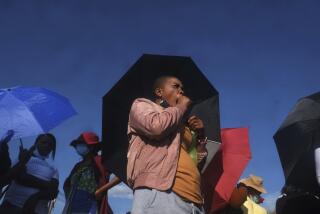Laos’ Campaign to Lure Tourists Goes Belly Up
- Share via
VIENTIANE, Laos — The Communist government of this hapless, landlocked country set a lofty goal for the start of the new millennium: to attract a million visitors with its “Visit Laos Year” promotion.
But 2000 turned into a disaster on every level, and now even optimists believe that Laos will need far more than a year to undo a generation of mismanagement.
With the government gridlocked and rife with political squabbles, the situation grew so serious this year that President Khamtai Siphandon warned senior officials in August that the country could disintegrate unless rival factions resolved their differences. He suggested that the ruling party consider reforming its radical policies to reflect today’s “economic and political realities.”
The first hint that 2000 would be a tough year came in March, with a warning by several Western governments that banditry and an insurgency in the north made travel there perilous. Then the aging fleet of 17 Russian- and Chinese-made planes flown by the national carrier, Lao Aviation, was deemed unsafe by most embassies.
If that wasn’t enough to keep visitors away, a string of unexplained bomb blasts shook this capital, with one injuring at least six foreigners in a restaurant and another killing a man at Vientiane’s international airport. The tourist campaign was stillborn.
Adding to the year’s woes, the Malaysian and Singaporean airlines canceled their flights to Laos because of lack of demand. And a Cabinet minister, Khamsay Souphanouvong, left for New Zealand in an apparent defection.
Relations with Washington cooled after two Laotian Americans disappeared last year on the Thai border. And 60 Laotians launched an ill-fated attack in July on the Chong Mek border post in southern Laos and briefly hoisted the royal flag in the naive belief that the country was ripe for a popular uprising.
The abortive Chong Mek strike came as Prince Soulivong Savang, heir to the kingdom’s throne, was on a monthlong tour of the United States to talk to Laotian exile groups and rally support in Congress for democratic reform in his homeland.
Though he denied any involvement, the attack served the interests of both opposition and government forces. It enabled the former to say resistance was growing within Laos and the latter to point to an unidentifiable enemy as justification for its paranoia and obsession with security.
“Yes, Laos had problems in 2000, and these problems will lead to instability because of the Communists’ suppression of their opponents,” Savang said in a telephone interview from Paris, where he lives in exile with other surviving members of the royal family.
Savang, 37, who fled Laos in 1981 with his younger brother, Dhayavong Savang, on a raft that crossed the Mekong River to Thailand, said he would go home if democracy was restored but would leave the monarchy’s future up to the Laotian people. The previous king, queen and crown prince, the last of whom was Savang’s father, were taken to reeducation camps after the Pathet Lao Communists won power in 1975. The three either died or were killed in captivity. Savang’s mother now runs a small guest house.
There are, though, no indications that the Pathet Lao, who came out of mountain caves to replace the monarchy a generation ago, have any interest in sharing power. Political analysts say that the royal family might resonate with the estimated 700,000 Laotians who live in the United States, France and Australia but that has little apparent relevance to the more than 5 million Laotians inside the country, most of whom were born after the Communists seized control.
Even by generous standards, the eight members of Laos’ secretive Politburo--the youngest is 70--have proved inept. Foreign investment in Laos has evaporated, hotels run at 30% occupancy in peak season, blackouts in Vientiane are common, human rights are frequently abused, and foreign assistance makes up 16% of Laos’ gross domestic product and 80% of its public investment. Most of the educated middle class lives abroad.
In the 1960s, Laos lived under the shadow of the Vietnam War, Savang said, “but people enjoyed freedom, civil servants received their salary, young people received standard education, health care was acceptable, the free economy system ran.”
“What a pity. Due to the Communist regime, the government missed the opportunity to develop Laos. The current president has called on Lao people abroad to participate in developing Laos. But without democracy, nobody will reply.”
Not everyone remembers the 1960s so fondly. A bewildering array of factions--neutralists, royalists, Communists--fought one another for power, and the CIA directed a nominally secret American war that made Laos one of the most heavily bombed countries in history as the Pentagon tried unsuccessfully to sever North Vietnam’s supply lines to South Vietnam.
The government made a stab at economic, but not political, reform in the mid-1990s and appeared to be making admirable progress. But Laos was one of the hardest-hit victims of Southeast Asia’s 1997-98 economic crisis, and the Politburo reacted by withdrawing into what it perceived as the safety of its Communist cocoon.
Western political analysts say that, despite the president’s warning, there is little likelihood that Laos will disintegrate and even less chance of the government’s being toppled by any sort of revolt. Nor do they think a return of the monarchy is in the cards. For the laid-back and graciously warm Laotians, that means escaping the ranks of the world’s poorest nations almost certainly will remain only a dream.
More to Read
Sign up for Essential California
The most important California stories and recommendations in your inbox every morning.
You may occasionally receive promotional content from the Los Angeles Times.













